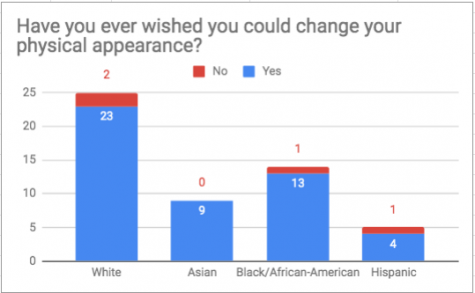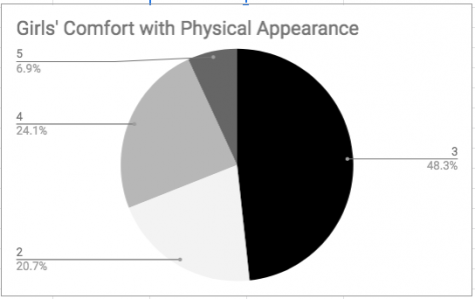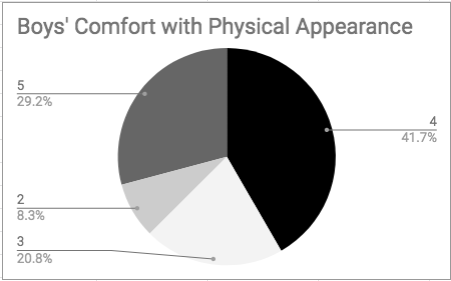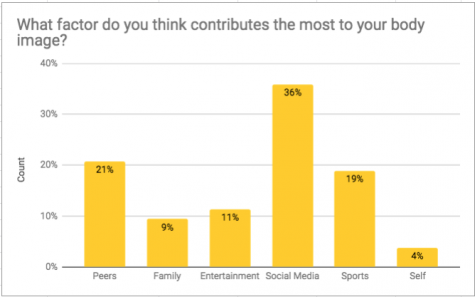Preoccupied with Physique
Breaking Down the Body Image of Teenagers
June 4, 2019
Though our physical appearance may not always be changing, our perception of it constantly seems to be—thanks to the ever changing values and standards that make up the cultures we identify with. What is the result? Individuals, particularly teens, are caught in a never-ending cycle of confusion with their body image. Unfortunately, it’s a phenomenon that is quite difficult to circumvent, and even more difficult to address. The only way is to dig down to the core of the problem.
What Is Body Image?
As described by the US Department of Health and Human Services, body image is “how you feel about your appearance.” This may manifest in how you think about your body itself—such as your height, weight, and other physical features—how you feel in your own skin, and how you behave as a result of these feelings.
Thus, having a healthy body image means feeling comfortable in your body and feeling good about the way you look. Studies have found that this corresponds with good physical and mental health, improved self-esteem, self-acceptance, and healthy behaviors.
On the other hand, negative body image can lead to low self-esteem, as well as a preoccupation with eating and exercising, which often causes individuals to isolate themselves. Unhealthy practices, accompanied with intense disappointment, shame, and guilt, may arise, increasing the risk for eating disorders, depression, anxiety, or other mental health conditions.
According to University of Sheffield lecturer Maggie Wykes, obsessions over body image have historical precedents like ascetic fasting. For centuries, various cultures have imposed several standards and values over bodies, especially among women.
In the 1950s, the “ideal” measurements for women in the US were a 36-inch bust, 24-inch waist, and 36-inch hips—which are often extremely difficult or impossible to achieve. These measurements grew slimmer throughout the following decades; according to researchers, this shift may have been a result of a popular model named “Twiggy,” who was 5’7” and weighed only 90 pounds, calculating out to an extremely underweight body mass index of 14.1.
Today, the issue has not improved much. Worldwide, body image issues—and thus, eating disorders and other related conditions—have increased significantly. Throughout the ’80s and ’90s, studies showed that more than half of American women expressed unhappiness with their bodies, especially with regard to their weight; however, only one-third of all women were actually statistically above their “normal” weights for their height. The result of these perceptions is discomfort and, often, unhealthy habits.
Though body image is a universal phenomenon, it is largely shaped during late childhood and adolescence. Especially due to sudden physical changes that come about during puberty, teenagers often become hyper-aware and self-conscious about their bodies. Dissatisfaction has been observed to emerge among girls as young as eleven-years-old, continuing into their late teenage years. This discontent often takes form in unhealthy eating habits, compulsive exercise, or social isolation and anxiety—all things that are detrimental during teenage developmental years.
Even at Cambridge Rindge and Latin School (CRLS), of the 53 students who took part in a Register Forum survey, only four students stated that they had never wished that they could change their physical appearance. In this important physical growth period, however, wanting to change your body is very dangerous and often prompts teens to “under-eat at [a] vital period of physical development, according to Wykes.

Data from a Register Forum survey of 53 CRLS students.
Breaking It Down into Categories
The issue of body image among teenagers can be further broken down into categories. According to several studies, adolescent girls are more prone to suffering from negative body image compared to adolescent boys. This is also accompanied by concerns that women have become too “sexualized,” feeding into the patriarchal concept that women are supposed to please men. According to the US Department of Health and Human Services, “this [imbalance] may be because many women in the United States feel pressured to measure up to strict and unrealistic social and cultural beauty ideals.” In fact, researchers think that this discrepancy may be part of the reason that more women struggle with depression than men.
Still, the rates of negative body image among men are rapidly catching up. In mass media, tall, lean, and muscular men are also often treated as “commodities or objects to be gazed upon.” A recent 2015 study conducted by Chapman University found that, contrary to popular opinion, men are just as likely as women to feel unsatisfied with their physiques.
At CRLS, there still seems to be a subtle difference between males and females’ perceptions of their bodies. When asked to rank their comfort levels towards their body from 1-5, with 1 being “very uncomfortable” and 5 being “very comfortable,” the most common answer among those who identified as girls was a rating of 3, with 48.3%. Only 6.9% felt that they were “very comfortable” with their physical appearance. On the other hand, the most common answer among those who identified as boys was a rating of 4, with 41.7%. 29.2% were “very comfortable.”

Data from a Register Forum survey of 53 CRLS students.
Researchers have also established that while women tend to regard themselves as much bigger than they really are, men tend to regard themselves as much thinner than they are. In addition to this difference in perception, girls and boys at CRLS seem to engage in different types of behaviors to varying extents. When asked about whether they had ever felt like they had to “restrict, bulk, or otherwise adjust your eating to change your physical appearance,” 66% of female students and 42% of male students answered “yes.” When asked about whether they had ever felt like they had to exercise in a certain way or for a certain amount of time for the same reason, 90% of female students and 83% of male students answered “yes.” In both cases, female students dominated.

Data from a Register Forum survey of 53 CRLS students.
Identifying Root Causes
A widely accepted notion is that the individuals who you are most often surrounded by have a great impact on your thoughts and feelings. In the case of peer pressure, simply feeling out of place or hearing a mindless statement can compel someone to want to look a certain way. Many of the surveyed students at CRLS explained that peers, who are the people that they are most often around, are often the birthplace of the greatest judgments about them; 21% of students circled “peers” as the factor that contributes the most to their body image.
Some took a slightly different direction, circling “family” as the most significant factor. An anonymous senior female explained, “I grew up around them, so the way they looked formed my body image.” This is not a new finding, however. According to many studies, parental influences are extremely impactful on a child’s body image. In fact, daughters are two times as likely to have ideas about dieting when their mother diets.
An individual’s hobbies ironically also create similar stressors, impacting their body image greatly. Because of the high premium on physical fitness and athletic performance in sports, many athletes become fixated on their physique. Among CRLS students, 19% claimed that sports were the most significant contributor to their body image. In many ways, the effect can be positive. “If people are participating in athletics, some of the focus is taken away from trying to shape the body to fit a societal ideal, and towards being a healthy and successful athlete,” explained Simon Luden, assistant coach of the CRLS boys crew team.

Data from a Register Forum survey of 53 CRLS students.
However, many sports also seem to have a “typical” or “ideal” body type, which can often lead to greater dissatisfaction. “[The] dance industry is very focused on body type,” junior Abby Cohen affirmed. “I am constantly aware of how I appear and how I wish I could be the ‘ideal’ ballerina body type.” Sports with weight classes are yet another version of the problem, supporting a preoccupation with body mass. At CRLS, crew is one of these sports; lightweight rowing, in particular, forces athletes to be on a limited caloric intake while performing very strenuous physical activity. “This can lead to athletes starving themselves and always striving to be lighter and skinnier,” explained assistant coach Luden.
This concern over sports, however, seems to be more prevalent among men. Instead, women seem to be more affected by social media. Social media is also complemented by all other forms of mass media. According to Wykes, the University of Sheffield lecturer, the growth of “fasting” and the “focus on the body rather than the soul” largely parallels the explosion of mass media in the past 40 years. With the media focusing on unrealistic, unobtainable, and highly stylised appearances, this shift does not come as a surprise to many. “Traditional beauty pounds a very narrow lens as to how we should look,” an anonymous female junior commented.
This “narrow lens” shines through many forms of media and popular culture, including retail, models, celebrities, and magazines. Individuals are often forced to make their best effort to work within the standards that are set by physical “ideals.” Celebrities promote certain products and brands use slim models. “Mostly everyone who is famous often has the ‘perfect body,’” said freshman Emilie Negre. “Even though magazine covers of celebrities and other famous figures are often photoshopped, people forget, and it makes them feel worse about themselves.”
In addition, entertainment provides another important vehicle for developing ideal body types. Over the last 30 to 45 years, the depiction of men in Hollywood, cartoons, toys, and superheroes has grown much more muscular and lean—prompting men in the real world to become less satisfied with themselves. “There’s this drumbeat that muscularity equals masculinity, and so we’re seeing more and more young men with muscle dysmorphia [critical misperception of one’s body],” explained Dr. Harrison Pope, director of the Biological Psychiatry Laboratory at the McLean Hospital.
A similar idea also exists that everything changes for the better when you are thin. In the renowned show Friends, young and fat Monica is a slob, inelegant, and desperate, while adult and thin Monica is a clean-freak with grace. In the sitcom New Girl, young and fat Schmidt is a loser, while old and muscular Schmidt is hot and popular. As Sofie Hagen, a writer for The Guardian, writes, “It is almost as if Hollywood can’t imagine a fat person who is graceful, cool, and sexy. It is as if you can’t possibly be fat and happy.”
The overall culture of the United States may be a cause for such concerns. From the “first moment they are alive, throughout much of their childhood, and into adulthood,” individuals are bombarded by messages about how they look and how they should look. Amerley Ollennu, a writer for The Independent, writes, “There is so much focus put on the way we look on the outside and not enough on the way we feel on the inside.”
These norms have also established the fact that weight loss is always a positive thing. Such praise can trigger food-related anxiety and encourage unhealthy behavior. “It’s as if with every compliment they are saying ‘you didn’t look good before,’ ‘you weren’t enough the way you were,’ and that being slim is the true epitome of beauty,” Ollennu writes. “By praising me for my weight loss, they simply reinforce the status quo, that thin is the ideal body type, and in so doing they do themselves a disservice too.”
Moving Forward
Several concerns that emerge from the issue of negative body image are caused by a lack of awareness for the problem. Because of the normalization of body dissatisfaction and dysmorphia, as well as restrictive behaviors, it is often hard to recognize when one crosses over into dangerous habits—especially when there are already established standards set in place in athletics and entertainment. Assistant coach Luden said, “[The issue] is usually brushed off as humor, but there are many people that have ended up with serious eating disorders as a result.”
Even with proper acknowledgment, the problem cannot be improved unless individuals feel comfortable getting help—something that is unfortunately hampered by common stigmas surrounding mental health. Studies have unanimously shown the great impact that proper treatment has on issues that may stem from negative body image. According to the National Eating Disorders Collaboration in Australia, the most effective approaches are focused on “building self-esteem and positive body image, and a balanced approach to nutrition and physical activity.” Common approaches include anxiety and depression medications, support groups, traditional psychotherapy, and mindfulness.
However, only addressing the aftermath completely ignores the root of the problem: the culture that places so much value on physical appearance. Little can be done unless this core issue is tackled; “challenging beauty ideals and learning to accept your body shape,” according to the National Eating Disorders Collaboration of Australia, is one of the most impactful changes individuals can make.
This piece also appears in our May 2019 print edition.
